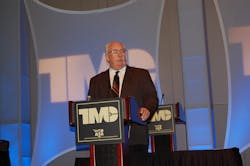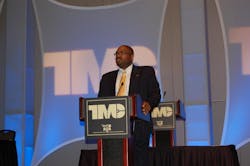More integration between tractor and trailer, more focused trainer on driver skills, and increased adoption of a wide variety of aerodynamic devices will most likely be the main areas of focus as new fuel efficiency rules begin to take hold of the trucking industry by 2017 and beyond.
That’s according to a panel of government and industry executives convened at a technical session during the 2014 Technology & Maintenance Council annual meeting in Nashville, TN.
For example, Stephan Lemieux – manager of the on-road heavy duty diesel section at the California Air Resources Board (CARB) – provided insight by phone on how trailers will be affected by the so-called “next generation” or “Phase II” heavy-truck fuel efficiency rules aimed at reducing greenhouse gas (GHG) emissions.
“Right now we’re looking at what trailers to include in the new rules,” he noted, with current evaluations including flatbeds, 28-ft. “pup” trailers, and tankers. “We’re even looking at the aerodynamic ‘drivers’ for vocational vehicles.”
Lemieux added that the rapid uptick in sales of aerodynamic devices over the last several years – from a mere 2,200 such devices in 2008 to over 180,000 units in 2012 and over 400,000 units last year – should help continue to lower acquisition costs for fleets as well as boost their return on investment (ROI) calculation for such trailer systems.
“The cost of trailer aerodynamic devices average about $2,500 per trailer in 2008, requiring about a 30 month ROI payback period for a fleet averaging 105,000 miles annually with a tractor-to-trailer ration of 2.5 to 1,” he said. “By 2012 that cost dropped to $1,250 per trailer with the payback period falling to 11 months and by 2013 reached $1,000 per trailer with an ROI of under 11 months.”
Dwayne Haug, associate VP of equipment purchasing for TL carrier Werner Enterprises, emphasized that while both the industry and government are looking at what he called “comprehensive solutions” to improving the fuel efficiency footprint of tractor-trailers, the impact of any solutions on base sticker prices cannot be an afterthought.
“The current average age of the Class 8 fleet is 6.6 years,” he explained. “At Werner our average Class 8 fleet is 2.3 years but we’re keeping them longer. We used to get rid of them at 250,000 to 300,000 miles but now hold on to them until 500,000 miles. The new trucks are better and more fuel efficient but they cost a lot more too.”
While Werner – which operates a fleet of 7,000 tractors – has experienced in Haug’s words “six years of steady miles per gallon improvement,” a good portion has come from reducing out-of-route and empty miles, though he said the Nebraska-based TL carrier has bought more aerodynamically-shaped trucks, trailer skirts, automatic tire inflation systems, speed limiter technology, plus anti-idling systems such as auxiliary power units (APUs) and fuel-fired cab heaters.
He stressed, too, that the skills of the truck driver population remains critical to future fuel saving efforts. “Our most important assets are the men and women who drive our trucks every day,” Haug added. “Retaining experienced drivers not just for Werner but for the industry is important. They need to stay put and help us accomplish our fuel saving goals.”
Scott Webb with New Mexico-based Mesilla Valley Transportation (MVT), echoed Haug’s observation about drivers, noting that in MVT’s experience about half of the fuel gains experiences by its 1,150 tractors (comprised of 850 company-owned units and 300 contractor owner-operators) comes from how its rigs are operated and half from technological sources.“We literally do hundreds of things to try and improve fuel economy since we were founded in 1981, but the critical pieces we’ve found to be minimizing the gap between the tractor and trailer and slower driving,” he noted. “Drivers who drive slower save fuel; and saving fuel helps our bottom line.”
Yet Webb (seen at right) feels fuel efficiency should not be the focus of regulatory efforts. “In terms of future regulations, we’d rather see things made voluntary; let the market decide best how to save fuel,” he said.
But Avron Mitchum, program manager with the Environmental Protection Agency (EPA), countered that the “Phase I” fuel efficiency effort is returning money to the pockets of truckers as well as to the U.S. economy as a whole.
“The Phase I projections for 2014-2018 is that we’ll use 530 million fewer barrels of oil, resulting $50 billion in fuel savings and $49 billion in net benefits to society,” he said. “We’ve seen a lot of support for Phase I and hope for the same support for Phase II.”Mitchum (seen at left) did note that EPA estimates the average cost for a single tractor-trailer to comply with the Phase I rules ranges between $5,000 and $6,000, resulting in annual fuel savings that range from $1,500 to $3,750 annually based on type of application.
“That results in a payback period of 1 to 2 years and a net savings of $73,000 over lifetime use of that tractor-trailer,” he said.
For Phase II, he said EPA – which must again write the rules in conjunction with the National Highway Traffic Safety Administration (NHTSA) as both agencies did for the Phase I regulations – will look at tractor-trailers as a “system.”
“We’ll be looking at a suite of technologies to piece together into a single package,” Mitchum explained. “We’ll see how we can feed that into the Phase II rulemaking.”
Sam Waltzer, an environmental engineer with the EPA, stressed that the agency expects Phase II rulemaking to be a cooperative effort with industry involvement.
“We’ll look to address fleet interests such as technology performance, the tradeoffs, and performance limits,” he emphasized. “With OEMs, we’ll look to examine technological potentials, conduct ‘apples-to-apples’ comparisons, and use standardized test methods.”
Werner’s Haug noted, though, with the Phase II rules, the industry not only faces a lot more work but that the regulations will cost trucking a lot of money, too.
“So we need to have smarter implementation. We need to understand that everyone [in trucking] operates equipment differently; that what works for one doesn’t work for all,” he stressed. “And there isn’t necessarily any low hanging fruit left anymore; we’re getting a diminishing return in some respects from fuel efficiency investments.”
About the Author
Sean Kilcarr
Editor in Chief
Sean Kilcarr is a former longtime FleetOwner senior editor who wrote for the publication from 2000 to 2018. He served as editor-in-chief from 2017 to 2018.


